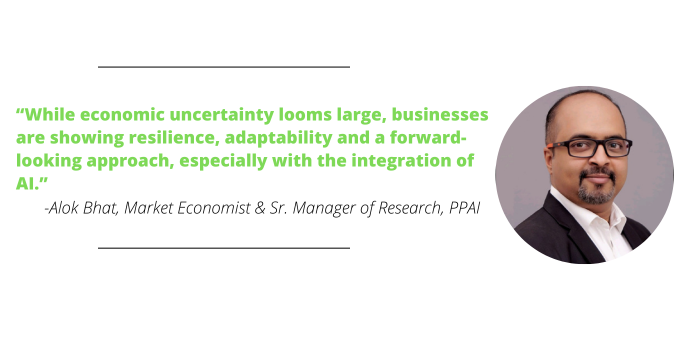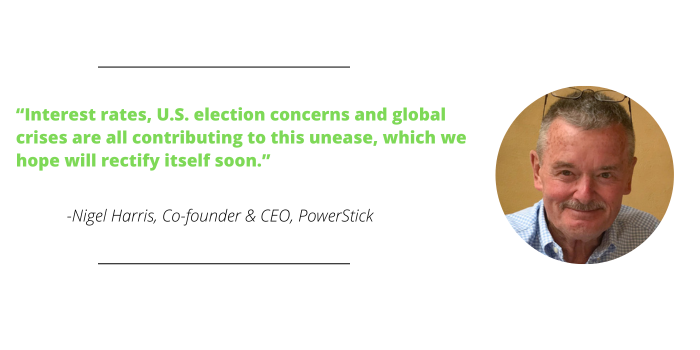August-September Was Promo’s Slowest Two-Month Period Of 2023

Promotional products industry revenue grew only 1.3% in August and September, the slowest two-month period of the year so far, according to PPAI Research.
- That’s below the annual rate of inflation, which was 3.7% in August, according to the latest U.S. Labor Department data.
- The latest revenue data isn’t cultivated from the same methodology as the annual Distributor Sales Volume Estimate, which polls distributors of all sizes. Rather, the current assessment is discerned from the aggregated results of PPAI 100 suppliers responding to a flash survey.
Alok Bhat, market economist and senior manager of research at PPAI, attributes the industry’s sluggish growth rate over the past two months to a variety of factors, such as economic uncertainty, aggressive price competition and extended sales cycles.
Despite these challenges, Bhat argues that the industry's proactive measures and adaptability hint at potential resilience in the future.
 “The promo industry is navigating a complex landscape of economic challenges and technological opportunities,” Bhat says. “While economic uncertainty looms large, businesses are showing resilience, adaptability and a forward-looking approach, especially with the integration of AI. Balancing growth aspirations with ethical considerations, especially around data, will be pivotal for the industry's future trajectory.”
“The promo industry is navigating a complex landscape of economic challenges and technological opportunities,” Bhat says. “While economic uncertainty looms large, businesses are showing resilience, adaptability and a forward-looking approach, especially with the integration of AI. Balancing growth aspirations with ethical considerations, especially around data, will be pivotal for the industry's future trajectory.”
Supplier Challenges
Economic uncertainty emerged as the most significant challenge for PPAI 100 suppliers, cited by a whopping 82% of respondents.
- Indeed, the outlook for the economy has been dampened since PPAI’s previous bi-monthly sales report, which assessed that industry sales rose 6.2% over the year prior during June and July.
As far back as last year, many financial institutions and economic forecasts have been predicting that conditions are ripe for a recession. Bloomberg Economics recently produced a model designed to predict the decision-making process of the National Bureau of Economic Research, which determines whether the U.S. is officially in a recession.
Based on employment, consumer spending, income measures and factory output, the model declared that there’s a “better-than-even chance” that a recession will be called in 2024 and actually begin at the end of 2023. Tipping the scales in favor of an economic downturn are student loan payments resuming, high oil prices and drastic insurance premium increases.
RELATED: Promo Pros Struggle With Student Loan Debt
“Interest rates, U.S. election concerns and global crises are all contributing to this unease, which we hope will rectify itself soon,” says Nigel Harris, co-founder and CEO of Ottawa, Ontario-based PowerStick – ranked the No. 33 supplier in this year’s PPAI 100.
 Price competition (41%) and lengthy sales cycles (36%) also pose significant challenges, according to PPAI Research, suggesting a competitive market landscape and potential delays in decision-making processes.
Price competition (41%) and lengthy sales cycles (36%) also pose significant challenges, according to PPAI Research, suggesting a competitive market landscape and potential delays in decision-making processes.
Harris has noticed a lack of “whale” opportunities that his company traditionally sees this time of year. “Our revenues are flat, and we’re seeing the usual number of orders,” he says. “But the requested quantities tend to be in the hundreds and thousands rather than in the tens and hundreds of thousands.”
While 23% of PPAI 100 suppliers pointed to increased customer expectations as a major hurdle, only 14% felt the brunt of supply chain disruptions, indicating great improvement from the height of the COVID-19 pandemic.
Despite the prevailing challenges, the majority of PPAI 100 suppliers (57%) chose to maintain pricing stability, while 19% felt the need to increase prices due to rising costs.
Distributor Challenges
It was more of the same on the PPAI 100 distributor side, as 67% reported that economic uncertainty was their most significant challenge, suggesting that external macroeconomic factors have been a considerable barrier to sales.
“Our August sales were where we expected them to be, but September seemed a little slow compared to what we usually see,” says JoAnn Gilley, CEO of Waukegan, Illinois-based Overture Promotions – ranked the No. 15 distributor in the PPAI 100.
“Economic uncertainty, which is related to high interest rates and less money being available, seems to be the only available explanation, although it’s hard to square with the good jobs reports and the Fed holding. Maybe it’s all the geopolitical uncertainty, or whether COVID will return in a meaningful way this fall or winter?”
 Meanwhile, one-third of PPAI 100 distributors found price competition, lengthy sales cycles and increased customer expectations, respectively, to also be significant challenges.
Meanwhile, one-third of PPAI 100 distributors found price competition, lengthy sales cycles and increased customer expectations, respectively, to also be significant challenges.
Supply chain disruptions – a challenge that has been prevalent in various industries recently – was a concern for only 6.7% of respondents.
Despite the varying market conditions, more than three-fourths (77%) of PPAI 100 distributors have maintained pricing stability. Conversely, less than a quarter (23%) have had to increase prices due to rising costs, possibly hinting at inflationary pressures or increased production costs.

